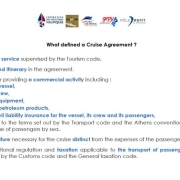Commercial Vessels and Charter Yachts
9 April 2016




Commercial vessels and charter yachts are used to transport passengers for a rental fee, under the care of a professional crew (in France, the certificate of registry of these ships is blue). These yachts are also used for rental with skipper or full crew. They are designated as vessels in commercial use or Charter Yachts in English.
Most commercial vessels and charter yachts are limited to a number of 12 passengers (sometimes 14 with waiver or supra-numeral list) transported (in addition to their crew) in all maritime areas. Yachts in commercial use navigating exclusively in national waters may be subject only to local regulations. For more passengers on board, it usually takes a ‘Passenger Class’ vessel, which are much larger yachts and capable of carrying many more people on board.
TYPES OF BOATS AND SERVICES
Certified or classified commercial vessels and charter yachts, are motor yachts as well as sailboats, designed for pleasure that run a business by passenger charter contracts, usually based upon time or stay. In addition, these vessels are provided with a professional crew, themselves certified to be able to be part of a rental crew. Passengers undertaking a tourist or recreational cruise are carried, under the responsibility of the owner, his representative or his agent. These include:
Boats for daily excursions or day-charter: These are boats that can receive and carry passengers for relatively short cruises and whose services consist of taxi, boat trips, convoys or dining, and exclude accommodation on board beyond the rental day.
Cabin vessels: These are boats equipped and certified for the purpose of receiving, transport and accommodate on board, passengers for longer cruises of several days.
TYPES OF ACTIVITIES OF COMMERCIAL VESSELS AND CHARTER YACHTS
Different customers can charter a yacht for:
- A cruise on demand and for the period and destination(s) wanted,
- A passenger ride, a boat trip, a cruising journey at sea, a taxi,
- A diving excursion (diving with license only),
- A corporate event or meeting,
- A seminar,
- The promotion of a brand, trademark or company at an international event or exhibition,
- A birthday or other private events on request,
- Cultural discovery stopovers throughout a cruise.
COMMERCIAL VESSELS TYPES BY SIZE / CODE / CERTIFICATION
200 UMS Vessels (English Universal Measurement System): Motor vessels with a length up to 24 meters (or sail up to 30 meters in France).
In the British system, the most common in Europe and the Mediterranean, the operation of such vessels is covered and certified by the Small Commercial Vessels Codes of Pratice. In France, they are usually approved or certified by the NUC ‘Navires à Utilisation Commerciale’.
500 UMS Vessels: Motor vessels with a length up to 45 meters (or sail up to 50 meters in France).
Most of these vessels in Europe and the Mediterranean are licensed or certified by the British Large Commercial Yacht Code (LY2). In France, they are usually coded and certified by the RIF ‘French International Register’.
3000 UMS Vessels: Vessels with a length up to 100 meters for international and transoceanic cruises and long range, coded and certified by the LY2 or RIF when carrying passengers or up to 12/14 or under the Passenger Classes Code when fitted, equipped and able to carry a larger number of people.
REQUIREMENTS FOR CHARTER YACHTS AND BOATS IN COMMERCIAL USE
Accounting and Management: Unlike private use pleasure yachts and recreational vessels reflecting only expenses, commercial vessels and charter yachts generate rental income or revenue requiring accounting and to be declared. Therefore, they must have accounting (just like a business) for receipts, commercial revenue, sales expenses, VAT declaration (or other taxes), deductible VAT, provisioning allowance, supplies, expenditures etc…
Equipment required: According to the International law and various provisions of the Flagstate, the applicable regulation is much stricter and more demanding than that of a private use yacht. Commercial vessels and charter yachts are also subject to specific and appropriate regulations, including electrical equipment, rescue equipment, survival, medical, fire extinguishing devices, radio communications and navigation equipment. They must generally be equipped with a Global Marine Distress and Safety System (GMDSS) at sea.
Crew: Several professional qualifications are required for sailing commercial vessels and charter yachts. To drive one of these boats it is mandatory to have a degree of Master of Yachts (Yacht Master) suited to the size / tonnage of the vessel and its necessary endorsements.
The entire crew, including Second, Head Quarter, Shift Supervisors, Deckhands, Cooks, Stewards and Hostesses, must have, in addition to their diplomas, medical education (STCW 95), updated every five years, to provide emergency care and provide medical care to save life on ships at sea.
All crew members must be insured and under labour contract in accordance to the ship’s Flagstate, the Maritime Labour Convention (MLC) and the International Maritime Organization (IMO).
For more information or learn more about our fleet of commercial vessels and charter yachts, please contact Allied Yachting. Our Yacht Management team can also offer comprehensive solutions to classify, code and certify your boat.











